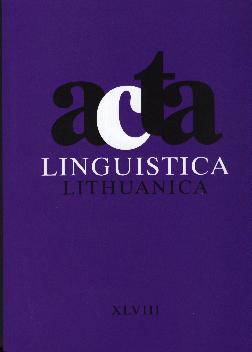Postverbų pateikimo problema Lietuvių kalbos žodyne
The problem of the coverage of postverbs in the Dictionary of the Lithuanian Language
Author(s): Rolandas MikulskasSubject(s): Language and Literature Studies
Published by: Lietuvių Kalbos Institutas
Keywords: Lithuanian; lexicography; postverb
Summary/Abstract: It was suggested some time ago that in certain Northern and North Western Lithuanian dialects the verb displays a ternary aspect opposition similar in its development to that of Latvian. The essence of the ternary aspect system is that in addition to the imperfective and the perfective aspects there is one more intermediate category for which the term ‘perficientive’ was proposed. The perficientive is formed by means of certain desemanticized case forms of nouns, analogous in their meaning and function to the prefixes of the perfective verb. For these, the term ‘postverb’ was proposed. When used with verbs with the general meaning of ‘annihilation’, these postverbs indicate that the action is coming to an end or is reaching a certain boundary. The most widespread postverbs are žemė(n) (local variants į þìmæ, þìmyn (þemýn), þìmynais (þemyna¤s)), la÷ka(n) (local variants la÷ko(n), la÷konais, la÷k), ðali¹, virðuõ (local variants virðù, virðu§, vi»ð). The article discusses the problem of the coverage of postverbs in dictionaries. In the Dictionary of the Lithuanian Language, such postverbs had to be classified in terms of parts of speech, and provided with grammatical markers. This was not done in a consistent way. Some are described as emphasizing particles, others as a special type of adverbs, still others are not distinguished from spatial adverbs. Grammatical labelling should, of course, be as consistent as possible. In the case of postverbs, the function of aspect marker should be given prominence. The examples should be selected in such a way as to reflect the geographical expansion of the phenomenon. It seems that the editors have not succeeded either in treating postverbs homogeneously or to present the illustrative material in a concentrated way. In most cases, postverbs do not formally differ from the corresponding adverbs or case forms and stand apart from them only by their grammaticalization. As a result of semantic bleaching, they have ceased to perform the function of spatial adverbials, so that it would be inaccurate to characterize them as ‘adverbs’. The term ‘illatives’ would be more accurate in view of the importance of the illative in the proces of formation of postverbs. Historically, most postverbs are illatives. An analysis of þìmë(n) and á þìmæ shows that the starting point of the process of grammaticalization as a perficientive marker is the use of þemë in the meaning ‘surface on which we walk or the ground on which we stand’. By virtue of this meaning, þìmë(n) and á þìmæ can express the boundary of a downward movement and hence also the completion of an action. Verb phrases with these illatives or their adverbial analogues þìmyn (þemýn) and þìmynais (þemyna¤s) can be divided into three semantic groups. They describe processes of decay, destruction or removal (separation). Rarely there is also an additional notion of downward movement, in which case the forms under discussion can also be interpreted as spatial adverbs
Journal: Acta Linguistica Lithuanica
- Issue Year: 2003
- Issue No: 48
- Page Range: 71-96
- Page Count: 25
- Language: Lithuanian

